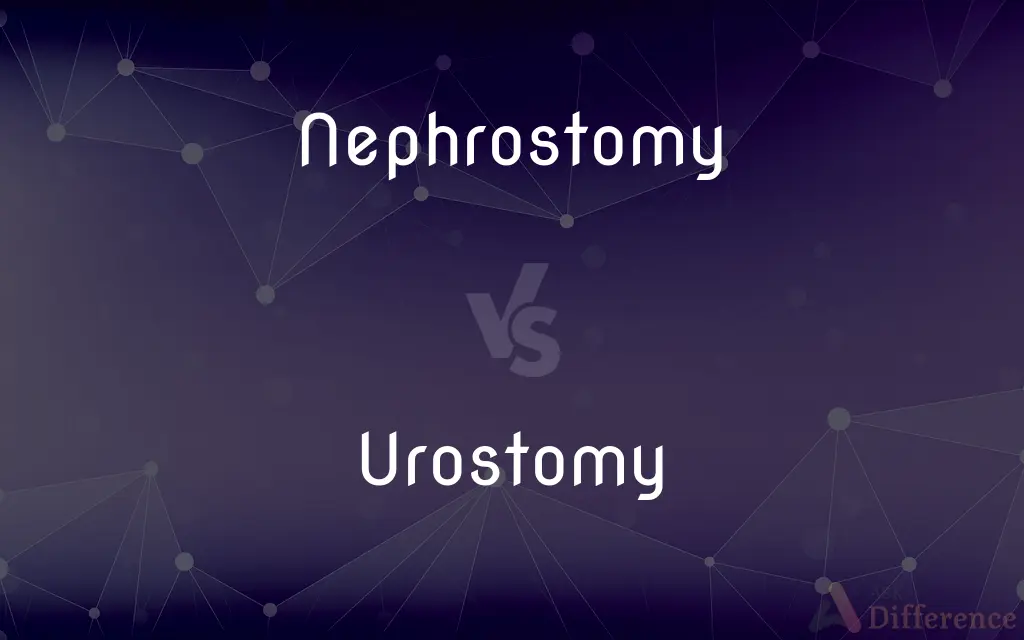Nephrostomy vs. Urostomy — What's the Difference?
Edited by Tayyaba Rehman — By Fiza Rafique — Updated on September 25, 2023
Nephrostomy is a surgical procedure to create an external opening from the kidney to the skin for urine drainage. Urostomy is a surgical procedure to redirect urine flow from the urinary system to a stoma on the abdomen.

Difference Between Nephrostomy and Urostomy
Table of Contents
ADVERTISEMENT
Key Differences
Nephrostomy is often done to relieve urinary obstructions or drain urine in cases of kidney dysfunction. Urostomy is typically performed when the bladder or urinary tract is removed or nonfunctional.
Nephrostomy involves creating an opening from the kidney to the skin. Urostomy involves diverting urine through a surgically created stoma on the abdominal wall.
Nephrostomy can be temporary, allowing for kidney drainage and recovery, or permanent in some cases. Urostomy is usually permanent, as it reroutes urine permanently through the stoma.
Comparison Chart
Meaning
Kidney-to-skin urine drainage
Redirecting urine via a stoma
Purpose
Relieving obstructions, drainage
Post-bladder removal, dysfunction
ADVERTISEMENT
Location
Kidney to skin
Abdominal wall (stoma)
Temporary vs. Permanent
Can be temporary or permanent
Typically permanent
Output
Directly drains kidney urine
Redirects bladder/urinary tract urine
Compare with Definitions
Nephrostomy
Surgical procedure creating a kidney-to-skin urine drainage.
The nephrostomy tube allowed urine to drain from the obstructed kidney.
Urostomy
Surgical redirection of urine through an abdominal stoma.
After bladder removal, a urostomy was performed to manage urine.
Nephrostomy
Surgically opening a route for kidney urine to exit externally.
Nephrostomy is crucial for patients with kidney drainage complications.
Urostomy
A permanent procedure to reroute urinary flow.
Urostomy is common after bladder surgery.
Nephrostomy
An intervention to relieve kidney obstructions or dysfunction.
The patient underwent nephrostomy to address kidney drainage issues.
Urostomy
Diverting urine through a surgically created stoma on the abdomen.
Urostomy pouches collect urine from the abdominal stoma.
Nephrostomy
Creation of an external kidney drainage route.
Nephrostomy is necessary when there are kidney drainage problems.
Urostomy
A surgical solution for urinary tract issues.
Urostomy improves quality of life for those with bladder problems.
Nephrostomy
A medical procedure to establish kidney-to-skin urine flow.
Nephrostomy tubes are used to bypass kidney blockages.
Urostomy
Creating an external urine exit point on the abdominal wall.
A urostomy bag is used to collect urine from the stoma.
Nephrostomy
A nephrostomy is an artificial opening created between the kidney and the skin which allows for the urinary diversion directly from the upper part of the urinary system (renal pelvis). An urostomy is a related procedure performed more distally along the urinary system to provide urinary diversion.
Urostomy
A urostomy is a surgical procedure that creates a stoma (artificial opening) for the urinary system. A urostomy is made to avail for urinary diversion in cases where drainage of urine through the bladder and urethra is not possible, e.g.
Nephrostomy
(surgery) The creation of a nephrostome
Urostomy
Surgical construction of an artificial excretory opening from the urinary tract.
Urostomy
A surgically constructed opening in the urinary tract allowing urine to exit the body; the procedure of making such an opening.
Common Curiosities
What is the primary purpose of urostomy surgery?
Urostomy surgery is performed when the bladder or urinary tract is removed or nonfunctional, redirecting urine flow externally.
Why is nephrostomy performed?
Nephrostomy is often done to relieve urinary obstructions or drain urine in cases of kidney dysfunction.
Is nephrostomy typically a temporary or permanent procedure?
Nephrostomy can be temporary for drainage and recovery or permanent in some cases, depending on the patient's condition.
How is urine collected after urostomy surgery?
Urine is collected in a pouch or bag attached to the abdominal stoma.
Is urostomy surgery reversible?
Urostomy is usually a permanent procedure, but in some cases, it may be reversible if bladder function is restored.
Can urostomy patients lead a normal life after the procedure?
Yes, urostomy patients can lead normal lives with proper care and management of the stoma and pouch.
Can nephrostomy tubes be removed once their purpose is served?
Nephrostomy tubes can be removed when the underlying issue is resolved or if they were temporary.
What conditions might require a nephrostomy procedure?
Nephrostomy may be necessary for kidney stones, tumors, obstructions, or kidney infections.
Is nephrostomy performed under general anesthesia?
Yes, nephrostomy is typically performed under general anesthesia.
What is nephrostomy?
Nephrostomy is a surgical procedure to create an external opening from the kidney to the skin for urine drainage.
Where is the stoma located in a urostomy?
In a urostomy, the stoma is created on the abdominal wall to redirect urine flow.
Are there lifestyle adjustments required after urostomy surgery?
Some lifestyle adjustments, such as diet modifications and pouch management, may be needed for urostomy patients to maintain quality of life.
Is urostomy surgery commonly done in cases of bladder cancer?
Yes, urostomy may be performed as part of treatment for advanced bladder cancer.
How is the stoma cared for after urostomy surgery?
Stoma care involves keeping the area clean, using appropriate pouching systems, and monitoring for any issues.
What is the role of a urostomy pouch?
A urostomy pouch collects urine from the abdominal stoma, providing a means of containment.
Share Your Discovery

Previous Comparison
Normal vs. Strange
Next Comparison
Coaching vs. FeedbackAuthor Spotlight
Written by
Fiza RafiqueFiza Rafique is a skilled content writer at AskDifference.com, where she meticulously refines and enhances written pieces. Drawing from her vast editorial expertise, Fiza ensures clarity, accuracy, and precision in every article. Passionate about language, she continually seeks to elevate the quality of content for readers worldwide.
Edited by
Tayyaba RehmanTayyaba Rehman is a distinguished writer, currently serving as a primary contributor to askdifference.com. As a researcher in semantics and etymology, Tayyaba's passion for the complexity of languages and their distinctions has found a perfect home on the platform. Tayyaba delves into the intricacies of language, distinguishing between commonly confused words and phrases, thereby providing clarity for readers worldwide.














































